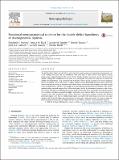Functional neuroanatomical evidence for the double-deficit hypothesis of developmental dyslexia
Author(s)
Black, Jessica M.; Stanley, Leanne M.; Tanaka, Hiroko; Sawyer, Carolyn; Hoeft, Fumiko; Norton, Elizabeth; Gabrieli, John D. E.; ... Show more Show less
DownloadGabrieli_Functional neuroanatomical.pdf (1.651Mb)
PUBLISHER_CC
Publisher with Creative Commons License
Creative Commons Attribution
Terms of use
Metadata
Show full item recordAbstract
The double-deficit hypothesis of dyslexia posits that both rapid naming and phonological impairments can cause reading difficulties, and that individuals who have both of these deficits show greater reading impairments compared to those with a single deficit. Despite extensive behavioral research, the brain basis of poor reading with a double-deficit has never been investigated. The goal of the study was to evaluate the double-deficit hypothesis using functional MRI. Activation patterns during a printed word rhyme judgment task in 90 children with a wide range of reading abilities showed dissociation between brain regions that were sensitive to phonological awareness (left inferior frontal and inferior parietal regions) and rapid naming (right cerebellar lobule VI). More specifically, the double-deficit group showed less activation in the fronto-parietal reading network compared to children with only a deficit in phonological awareness, who in turn showed less activation than the typically-reading group. On the other hand, the double-deficit group showed less cerebellar activation compared to children with only a rapid naming deficit, who in turn showed less activation than the typically-reading children. Functional connectivity analyses revealed that bilateral prefrontal regions were key for linking brain regions associated with phonological awareness and rapid naming, with the double-deficit group being the most aberrant in their connectivity. Our study provides the first functional neuroanatomical evidence for the double-deficit hypothesis of developmental dyslexia.
Date issued
2014-06Department
Institute for Medical Engineering and Science; Massachusetts Institute of Technology. Department of Brain and Cognitive Sciences; McGovern Institute for Brain Research at MITJournal
Neuropsychologia
Publisher
Elsevier
Citation
Norton, Elizabeth S., Jessica M. Black, Leanne M. Stanley, Hiroko Tanaka, John D.E. Gabrieli, Carolyn Sawyer, and Fumiko Hoeft. “Functional Neuroanatomical Evidence for the Double-Deficit Hypothesis of Developmental Dyslexia.” Neuropsychologia 61 (August 2014): 235–46.
Version: Final published version
ISSN
00283932